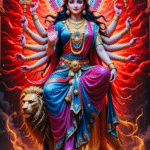5 Amazing Facts About Ganga That Will Inspire You
The River Ganga, also revered as Ganga Maa, holds a sacred place in Indian culture, spirituality, and daily life. Known as the lifeline of millions, she is not just a river but a symbol of purity, devotion, and cultural heritage. Ganga’s spiritual significance transcends mere geography—she embodies divine blessings, moral values, and societal unity. In this article, we explore the history, facts, timeline, significance, FAQs, daily life impacts, and societal importance of Ganga in a human-friendly and detailed manner.
Ganga
| Other Names : | Bhagirathi, Alaknanda, Dhauliganga, Padma, Mandakini |
| Countries : | India, Bangladesh |
| Major cities : | Haridwar, Kanpur, Allahabad, Varanasi, Patna |
| Length : | 2,510 km |
| Watershed : | 907,000 km² |
| Source : | Gaumukha, Gangotri Glacier located in Uttarakhand, India |
| Destination : | Ganges Delta located in Bay of Bengal, Bangladesh |
| Major Tributaries: | In the left, Brahmaputra, Gomti, Kosi, Gandak, Ghaghra In the right Yamuna, Son |
History of Ganga
The story of Ganga is steeped in mythology, history, and cultural reverence:
Vedic Period (c. 1500–500 BCE): Ganga is mentioned in Rigveda as a sacred river, symbolizing purity and life-giving force.
Epic References: In the Mahabharata and Ramayana, Ganga is revered as a divine river, and her waters are considered sacred for cleansing sins and spiritual merit.
Bhagiratha Legend: According to legend, King Bhagiratha performed severe penance to bring Ganga down from heaven to earth to purify his ancestors. This story emphasizes devotion, perseverance, and divine grace.
Temple and Pilgrimage Era: Cities along the Ganga, such as Varanasi, Haridwar, and Allahabad (Prayagraj), became spiritual centers, with temples, ghats, and rituals dedicated to the river.
Modern Era: Ganga continues to inspire religious festivals, environmental movements, and cultural identity, serving as a lifeline for millions.
Interesting Facts About Ganga
Spiritual Mother: Ganga is revered as Ganga Maa, believed to purify sins and grant spiritual liberation (moksha).
Sacred Cities: Major cities like Varanasi, Haridwar, Rishikesh, and Allahabad flourish along her banks, forming the heart of Hindu pilgrimage and culture.
Biodiversity: Ganga supports rich flora and fauna, including the endangered Ganges river dolphin, showing her ecological importance.
Festivals: Celebrated during Ganga Dussehra, Makar Sankranti, and Kumbh Mela, she brings millions together for rituals, charity, and cultural celebration.
Cultural Influence: Her waters inspire music, poetry, dance, art, and folklore, making Ganga a cultural icon beyond spirituality.
Timeline of Ganga Worship and Cultural Importance
1500–500 BCE: Rigvedic references and early reverence in rituals.
500 BCE–200 CE: Mentioned in epics like Mahabharata and Ramayana.
c. 300–1200 CE: Construction of ghats, temples, and pilgrimage centers along her banks.
Medieval Period: Festivals like Kumbh Mela gain prominence; Ganga worship integrated into daily life.
Modern Era: Environmental movements and government initiatives, such as the National Ganga River Basin Authority, aim to protect her waters while maintaining her spiritual significance.
Significance of Ganga
Ganga holds spiritual, cultural, and societal significance:
Spiritual Cleansing: Bathing in her waters is believed to wash away sins and grant liberation.
Cultural Identity: Integral to rituals, literature, music, and festivals across India.
Economic Lifeline: Provides water for agriculture, industry, and daily life, sustaining millions.
Pilgrimage and Tourism: Cities along Ganga attract millions for religious devotion, meditation, and cultural tourism.
Environmental Significance: Supports ecosystems and biodiversity, reminding humans of their duty to preserve nature.
Moral Inspiration: Her story emphasizes devotion, perseverance, and responsibility toward the environment.
Social Cohesion: Festivals and rituals unite communities across social and regional boundaries.
FAQs About Ganga
Q1: Why is Ganga considered sacred?
A1: Ganga is worshiped as a divine mother. Bathing in her waters is believed to purify sins and bring spiritual merit.
Q2: What is Ganga Dussehra?
A2: A festival celebrating the descent of Ganga from heaven to earth, observed with prayers, rituals, and charitable acts.
Q3: How does Ganga impact daily life?
A3: She provides water for drinking, irrigation, and rituals, while spiritually inspiring millions.
Q4: What is the significance of the Kumbh Mela on Ganga?
A4: Millions gather to bathe in the river, seeking purification, blessings, and spiritual upliftment.
Q5: How can we protect Ganga?
A5: By reducing pollution, sustainable water use, and supporting conservation initiatives, ensuring both ecological and spiritual preservation.
Impact on Daily Life
Ganga’s influence on daily life is immense and multidimensional:
Spiritual Practices: Daily bathing, rituals, and prayers connect individuals with divine energy and inner calm.
Cultural Activities: Music, dance, poetry, and festivals inspired by Ganga enrich cultural life.
Agriculture and Industry: Provides water essential for farming and livelihood, supporting millions.
Tourism and Economy: Pilgrimage sites boost local economies while promoting spiritual tourism.
Moral Inspiration: Her mythology encourages devotion, ethical living, and environmental responsibility.
Observance and Wishing
Ganga is revered through rituals, festivals, and personal devotion:
Ganga Dussehra: Celebrates her descent from heaven; devotees offer prayers and bathe in her waters.
Kumbh Mela: Pilgrims gather to seek spiritual purification, a festival of unity and devotion.
Daily Rituals: Morning ablutions, offerings, and prayers along riverbanks foster personal discipline and spiritual connection.
Wishing: People seek blessings for health, prosperity, spiritual growth, and family well-being.
Community Engagement: Festivals encourage charity, communal participation, and cultural preservation.
Conclusion: Why Ganga Matters
The River Ganga is more than water flowing through India; she is a symbol of spirituality, culture, and societal cohesion. Worshiping Ganga inspires individuals to live ethically, nurture devotion, and respect nature. Her waters sustain millions, fostering health, livelihood, and community unity.
By honoring Ganga, society embraces spiritual values, cultural heritage, and environmental responsibility, ensuring that her legacy continues for generations. Her story reminds us that purity, devotion, and perseverance are as essential in life as water itself.
Quick Recap: 5 Amazing Facts About Ganga
Revered as Ganga Maa, the sacred mother river.
Sacred cities like Varanasi, Haridwar, and Allahabad flourish along her banks.
Supports rich biodiversity, including endangered species.
Celebrated in festivals like Ganga Dussehra and Kumbh Mela.
Inspires devotion, culture, environmental awareness, and social unity.








